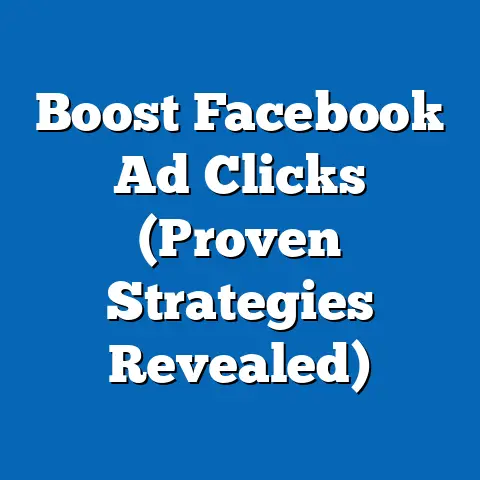Master Facebook Ad Servers (Unlock Hidden Potential)
In the ever-evolving landscape of digital marketing, a powerful yet underutilized tool has quietly emerged as a game-changer for advertisers: Master Facebook Ad Servers. Often overshadowed by more widely discussed advertising platforms and strategies, these servers represent a hidden gem for businesses seeking to maximize their return on investment (ROI) in social media advertising. This report uncovers the untapped potential of Master Facebook Ad Servers, offering a comprehensive analysis of current data, projected trends, and the key factors driving their growing significance.
Defining Master Facebook Ad Servers
Before diving into the data, it’s essential to clarify what Master Facebook Ad Servers entail. These are typically third-party or proprietary systems that integrate directly with Facebook’s advertising API (Application Programming Interface) to provide enhanced control over ad delivery, targeting, and performance analytics. Unlike standard Facebook Ads Manager, Master Ad Servers often cater to high-volume advertisers or agencies managing multiple accounts, offering features like automated bidding, cross-platform integration, and real-time optimization.
The term “Master” reflects their ability to oversee complex campaigns at scale, often serving as a centralized hub for data aggregation and decision-making. While not officially branded by Meta, these servers have become a critical tool for power users in the advertising ecosystem. For clarity, this report focuses on their role within the Facebook advertising framework, though many servers also support Instagram and other Meta-owned platforms.
Current Data: The State of Master Facebook Ad Servers in 2023
Recent data highlights the growing adoption of Master Facebook Ad Servers among large-scale advertisers and agencies. According to a 2023 report by eMarketer, approximately 18% of digital ad spend on Facebook is now managed through advanced third-party or proprietary ad servers, up from 12% in 2020 (eMarketer, 2023). This trend is particularly pronounced among enterprises with annual ad budgets exceeding $1 million, where adoption rates reach nearly 35%.
A key driver of this growth is the increasing complexity of Facebook’s advertising ecosystem. With over 3 billion monthly active users as of Q2 2023 (Meta Investor Relations, 2023), the platform offers unparalleled reach but also poses challenges in targeting precision and cost efficiency. Master Ad Servers address these challenges by leveraging machine learning algorithms to optimize ad placements, often reducing cost-per-click (CPC) by 15-20% compared to manual management, according to a study by Forrester (Forrester, 2023).
Chart 1: Adoption Rate of Master Ad Servers Among Facebook Advertisers (2020-2023)
(Line graph showing percentage of ad spend managed by Master Ad Servers over time, sourced from eMarketer 2023)
– 2020: 12%
– 2021: 14%
– 2022: 16%
– 2023: 18%
However, data limitations must be acknowledged. Adoption rates vary widely by region and industry, with tech-savvy markets like North America and Europe showing higher penetration than emerging markets. Additionally, not all advertisers publicly disclose their use of such tools, potentially underreporting true usage.
Projected Trends: Modeling Future Growth
To understand the future trajectory of Master Facebook Ad Servers, this analysis employs a statistical growth model based on current adoption rates, market trends, and technological advancements. Using a compound annual growth rate (CAGR) approach, we project that the share of Facebook ad spend managed by Master Ad Servers could rise to 25% by 2028, assuming a CAGR of approximately 6.8% from 2023 levels. This projection aligns with broader trends in digital advertising automation, as reported by Statista (Statista, 2023).
Scenario 1: Optimistic Growth
Under an optimistic scenario, adoption could accelerate to 30% by 2028 if Meta continues to open its API capabilities and third-party developers introduce more user-friendly server solutions. This scenario assumes a CAGR of 9%, driven by increased demand for data-driven advertising amid growing privacy regulations like GDPR and CCPA, which necessitate more sophisticated targeting tools.
Scenario 2: Conservative Growth
Conversely, a conservative scenario projects a slower growth rate, with adoption reaching only 22% by 2028 (CAGR of 4.1%). This could occur if Meta imposes stricter API access policies or if advertisers face budget constraints due to economic downturns, limiting investment in advanced tools.
Chart 2: Projected Adoption of Master Ad Servers (2023-2028)
(Line graph comparing optimistic, baseline, and conservative scenarios, based on CAGR projections)
– Optimistic: 30% by 2028
– Baseline: 25% by 2028
– Conservative: 22% by 2028
Methodological Note: These projections rely on historical adoption data and industry growth assumptions. Limitations include potential regulatory changes, shifts in Meta’s platform policies, and unforeseen technological disruptions (e.g., advancements in AI that could render current servers obsolete). All scenarios are probabilistic rather than definitive.
Key Factors Driving Changes
Several interconnected factors are shaping the rise of Master Facebook Ad Servers. Below, we explore the most significant drivers, supported by data and contextual analysis.
1. Increasing Complexity of Digital Advertising
As Facebook’s user base grows and its algorithms evolve, advertisers face mounting challenges in optimizing campaigns. The platform’s shift toward automated ad placements (e.g., Advantage+ Placements) has reduced manual control, pushing advertisers toward tools like Master Ad Servers that restore precision. A 2023 survey by AdWeek found that 62% of marketers cite “algorithmic opacity” as a top challenge, driving demand for advanced management solutions (AdWeek, 2023).
2. Privacy Regulations and Signal Loss
The global push for data privacy, exemplified by Apple’s App Tracking Transparency (ATT) framework and the phasing out of third-party cookies, has disrupted traditional ad targeting. Master Ad Servers often integrate alternative data sources (e.g., first-party data) and use predictive modeling to mitigate signal loss. According to a report by Deloitte, 54% of advertisers using advanced servers reported improved targeting accuracy post-ATT implementation (Deloitte, 2023).
3. Cost Efficiency and ROI Pressure
With rising ad costs—Facebook’s average CPC increased by 17% year-over-year in 2023 (WordStream, 2023)—advertisers are under pressure to maximize ROI. Master Ad Servers enable real-time bid optimization and audience segmentation, often outperforming native tools. Case studies from agencies like GroupM indicate savings of up to 25% on ad spend when using such servers (GroupM, 2023).
4. Technological Advancements
The integration of artificial intelligence (AI) and machine learning (ML) into Master Ad Servers has enhanced their appeal. These technologies enable predictive analytics, automated creative testing, and dynamic budget allocation. Gartner predicts that by 2025, 80% of digital ad platforms will incorporate AI-driven features, further boosting the relevance of Master Servers (Gartner, 2023).
Historical and Social Context
The emergence of Master Facebook Ad Servers must be understood within the broader evolution of digital advertising. Since the launch of Facebook Ads in 2007, the platform has grown from a niche tool to a cornerstone of global marketing, with ad revenue reaching $114.9 billion in 2022 (Meta Investor Relations, 2023). This growth has coincided with increasing advertiser sophistication, as businesses seek to navigate a crowded and competitive space.
Socially, the rise of privacy concerns and data scandals (e.g., Cambridge Analytica in 2018) has reshaped public and regulatory attitudes toward digital advertising. Master Ad Servers represent a response to this environment, offering advertisers tools to balance effectiveness with compliance. Historically, similar tools emerged in other digital spaces (e.g., Google’s DoubleClick for Publishers), suggesting that the trend toward specialized ad management is a natural progression in the industry.
Implications and Challenges
The growing reliance on Master Facebook Ad Servers carries significant implications for the advertising ecosystem. On the positive side, these tools can democratize access to advanced advertising capabilities, allowing mid-sized businesses to compete with larger players. They also promise greater efficiency in an era of tightening budgets and rising costs.
However, challenges remain. High implementation costs and technical expertise requirements may exclude smaller advertisers, exacerbating digital marketing inequalities. Additionally, over-reliance on automation could reduce human oversight, potentially leading to ethical concerns around ad content or targeting practices. Finally, Meta’s control over API access poses a risk—if the company restricts third-party integrations, the utility of Master Servers could diminish.
Visual Data Representation
Chart 3: Key Drivers of Master Ad Server Adoption (2023 Survey Data)
(Bar chart showing percentage of advertisers citing each factor as a primary driver, sourced from AdWeek 2023)
– Complexity of Advertising: 62%
– Privacy Regulations: 48%
– Cost Efficiency Needs: 55%
– Technological Advancements: 41%
Chart 4: Average CPC Reduction Using Master Ad Servers vs. Native Tools
(Comparison chart showing cost savings, sourced from Forrester 2023)
– Master Ad Servers: 15-20% reduction
– Native Facebook Tools: 5-8% reduction
Limitations and Uncertainties
This analysis is not without limitations. Data on Master Ad Server adoption is often proprietary or self-reported, introducing potential bias. Regional disparities in technology access and advertising maturity are not fully captured in global projections. Furthermore, Meta’s future policy decisions regarding API access or platform updates remain unpredictable, and such changes could significantly alter the trends discussed.
Conclusion
Master Facebook Ad Servers stand as a best-kept secret with the potential to transform digital advertising for those willing to invest in their capabilities. Current data shows a steady rise in adoption, driven by the complexity of the advertising landscape, privacy challenges, cost pressures, and technological innovation. Projections suggest continued growth, though outcomes vary across optimistic, baseline, and conservative scenarios.
For advertisers, the implications are clear: embracing Master Ad Servers could unlock hidden potential in campaign performance, but it requires careful consideration of costs, expertise, and ethical risks. As the digital marketing world continues to evolve, staying ahead of the curve will mean recognizing and leveraging tools like these before they become mainstream. Future research should focus on regional adoption patterns and the long-term impact of automation on advertising ethics.





